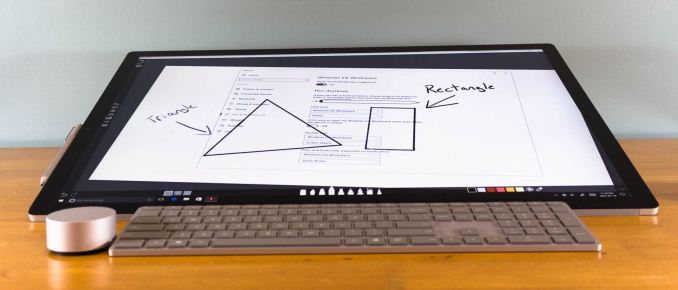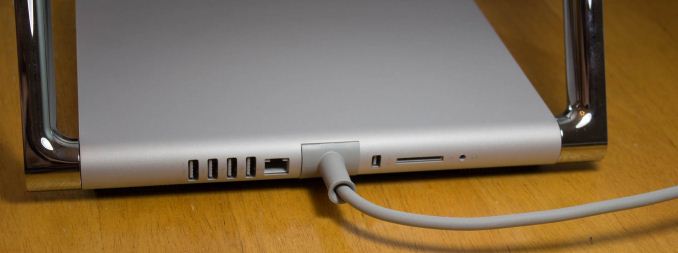The Microsoft Surface Studio Review
by Brett Howse on January 20, 2017 8:00 AM EST- Posted in
- Desktop
- Microsoft
- Surface
- Surface Studio
Design and the Zero-Gravity Hinge
Microsoft has built a brand around Surface, and that’s not an easy thing to accomplish. The Surface Studio fits in very well with the design ethos of the rest of the Surface lineup, and there has been quite a bit of attention to details paid in the creation of their first desktop computer. The first, and most obvious, is the finish, which matches perfectly with the other Surface devices, despite being made from aluminum rather than the magnesium alloy used on the portable products.
The 3:2 aspect ratio of the Surface Studio display is now a hallmark of the Surface brand (outside of Surface Hub), and having a taller display makes doing most tasks on a desktop a more pleasant experience. The increased surface area can’t be forgotten either, with the Surface Studio offering 17% more screen real estate than what's arguably the Studio's closest competitor, the 27-inch iMac, which amounts to an additional 54 square inches of display. Widescreen at 16:9 has never been a great aspect ratio for PC tasks, but the proliferation of high definition television seems to have moved the entire industry this way in an effort to save costs. When looking at the price of the Surface Studio, it’s important to remember that the entire display industry has moved to 16:9 as a standard, which impacts the entire supply chain and tooling required. Moving to an aspect ratio outside of 16:9 has large cost implications, but the end results are certainly worth it. Hopefully we will see a few other manufacturers use this as a means to source displays like this, much like the Surface Pro 3 and Pro 4 have ushered in more 3:2 devices at that much smaller size. And speaking of attention to detail, the Surface Studio is actually 28.125-inches diagonal, and as we'll see in a bit, that last 0.125-inches is very important.
It seems with Surface, Microsoft always wants to have a trick up their sleeve. With the original Surface RT and Surface Pro, it was the kickstand, which has been adopted by quite a few manufacturers for their own device since it works so well. When they launched their first laptop, the Surface Book, it was the muscle wire locking mechanism to remove the display from the base, as well as the dynamic fulcrum hinge to make the top-heavy laptop more stable. With the Surface Studio, the zero-gravity hinge is most definitely its signature design feature.
With two chrome arms flanking the base, the Surface Studio can almost effortlessly be folded down into a drafting table. The hinge mechanism provides a perfect counterbalance to the weight of the display, making it feel like it has almost no weight at all. The hinge is a single movement as well, so you don’t tip and fold the screen, but instead folding the screen also causes it to move down. While this does limit the functionality somewhat – for instance, you can't move the screen half way down and then fold it up straight again – the result is truly a wonderful design which almost needs to be seen in person.
Because you can’t tip the screen without folding it, once you stop at any angle, the screen is very solid to work with, although it is the most secure when folded all the way down to the 20° angle. You would think a large desktop display would not be ideal to use with touch, but the Surface Studio zero-gravity hinge invites you to be more interactive with it, by keeping the display close and folding it down when needed. More traditional all-in-one computers with a touch screen are nowhere near as easy to work with, since holding your arm in dead-air can be tiring, but the folded display doesn’t suffer from these burdens.
The PC base also exudes Surface quality, with the signature color, and cooling vents all the way around in the same fashion as the Surface Pro and Surface Book. The PC base can be disassembled from the bottom if required, for access to the storage and fans, but the remainder of the system is soldered to the board as you would expect in a small form factor device like this. The most frustrating part of the Surface Studio base is that all the inputs and outputs are on the rear of the device, so connecting something over USB, or inserting a SD card into the PC, is not as simple as it should be. This is a form over function decision, and it would be nice to see some of the ports offered at least on the side of the base to make it a bit easier to access.
The desktop PC market has not been as exciting to watch as the smaller and more portable laptops and tablets, but the Surface Studio sets a new high mark for desktop PC design and looks. Some of the decisions are form over function, but the majority of the design decisions actually improve the user experience. The zero-gravity hinge is a masterpiece of engineering, with such a smooth action that it really does feel like the display has no mass at all.













197 Comments
View All Comments
Manch - Monday, January 23, 2017 - link
I saw where you mentioned that the stress has to be supported at one end or another but its been proven that it can handle the stress just fine. As for the gap, while aesthetically unpleasing to some, or pleasing to others, I just don't see the big deal. Like others said, it ensures the keys don't contact the screen and unlike some laptops ahem Mac Book, key travel hasn't been sacrificed.BrokenCrayons - Tuesday, January 24, 2017 - link
I'd argue that it's been readily proven that the hinge design has been proven to fail under stress over time and there's little to no information available regarding the ability of the Surface Book to cope well with weight as a consequence to its design. However, there's a healthy dose of common sense that would make it pretty clear that half the plastic and metal would be less effective at supporting pressure from above or below than all of the plastic and metal.Key travel though, that's a point I agree with. Microsoft did manage to get that done in a manner of speaking, but it really didn't have to be that way to begin with if they'd bothered to add a largely unnoticable couple of millimeters of thickness. Instead, just like Apple and other companies, the Surface Book is chasing a pretty meaningless thickness measurement and surrendering functionality to do so. In the case of the Surface Book, that compromise is even more silly because the advantage of reduced thickness is ultimately still lost because there's a gap that ultimately makes the system thicker than it would have been had Microsoft recessed the keys and still maintained key travel distance.
jlabelle2 - Thursday, January 26, 2017 - link
- the hinge design has been proven to fail under stress over timeSo I am sure you have sources for that, do you?
- Instead, just like Apple and other companies, the Surface Book is chasing a pretty meaningless thickness measurement
They indeed made exactly the contrary. Instead of doing like Apple an put an almost no travel keyboard and standard hinge for specs bragging, they design a UNIQUE hinge that allow the screen to be further away when deployed for a better balancing and they put one of the maximum travel keyboard for comparably sized keyboard.
The hinge is not showing millimeters as you critizise but adds some at the gain of functionality.
nabnel - Friday, January 20, 2017 - link
Too many people comment and criticize the hinge design without actually understanding its function or why it's there. The hinge is designed to extend the effective base size when the laptop is opened, so that the weight distribution leaves it balanced and not top-heavy when used as a laptop. This is needed because the screen is heavier by a bit much than a typical laptop's screen. The other option wouldve to put more weight into the base, but that would increase the overall weight if the system.vLsL2VnDmWjoTByaVLxb - Friday, January 20, 2017 - link
The hinge design is criticized because it eventually results in a loose connection between the base and screen, the most important vital connection for a laptop. This results in keyboard drops, display resets, total machine crashes, and the inability to, you know, work on your $2000+ device. Having a Tablet isn't worth this instability.It's a design flaw. Every daily-used Surface Book will eventually see the hinge weaken and the above effects happen over and over again.
jlabelle2 - Monday, January 23, 2017 - link
- This results in keyboard drops, display resets, total machine crashesAny sources of that?
I have a Surface Pro 3 and having a removal keyboard never caused me the kind of issues you are claiming.
And having a separate tablet built-in in your laptop CERTAINLY worth it, I assure you.
- It's a design flaw.
The removal screen portion is a "design flaw"? You are kidding right?
BrokenCrayons - Monday, January 23, 2017 - link
"The removal screen portion is a "design flaw"? You are kidding right?"You're missing the context clues, I think intentionally, in order to suggest the idea of a removable screen/tablet is flawed in order to build a credible argument through suggesting that someone else is stating something stupid when that's not at all the case. Dockable tablets arent the problem. The hinge and connection, as already mentioned multiple times in this article's comments, is poorly engineered.
jlabelle2 - Thursday, January 26, 2017 - link
- The hinge and connection, as already mentioned multiple times in this article's comments, is poorly engineered.Which I think is an even more stupid comment. Look again the video of the hinge and compare to anything else on the market and you will realize that it is still unique and unrivalled design.
And anyone that own a Surface Book are praising the hinge, not the contrary.
BrokenCrayons - Thursday, January 26, 2017 - link
Unique doesn't automatically mean "better." I realize you want to defend this for psychological rather than practical reasons and that's completely okay. A handful of people can't help but fall in love with computers and honestly need to in order to justify why something is or isn't better than something else. Men in particular love comparing things and measuring differences in order to reach a conclusion that supports their underlying desires and will go as far as selecting other things that support their mental state. Say, comparing a Surface Book to a bottle of hand sanitizer and saying the Surface Book has better battery life and more storage space. I understand that it often can't be helped, but I encourage you to put human psychology under a critical microscope and attempt to transcend your biology during the process of thinking critically.Manch - Friday, January 27, 2017 - link
Please provide links for this massive hinge failure bc I cant find it.